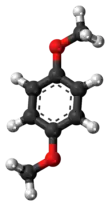| |||
| Names | |||
|---|---|---|---|
| Preferred IUPAC name
1,4-Dimethoxybenzene | |||
| Other names
Hydroquinone dimethyl ether; p-Methoxyanisole; Dimethyl ether hydroquinone; USAF AN-9; Dimethylhydroquinone ether; Quinol dimethyl ether; p-Dimethoxybenzene | |||
| Identifiers | |||
3D model (JSmol) |
|||
| ChEMBL | |||
| ChemSpider | |||
| ECHA InfoCard | 100.005.248 | ||
| EC Number |
| ||
PubChem CID |
|||
| RTECS number |
| ||
| UNII | |||
CompTox Dashboard (EPA) |
|||
| |||
| |||
| Properties | |||
| C8H10O2 | |||
| Molar mass | 138.166 g·mol−1 | ||
| Appearance | White crystals | ||
| Odor | sweet, nut-like | ||
| Density | 1.035 g/cm3[1] | ||
| Melting point | 54 to 56 °C (129 to 133 °F; 327 to 329 K)[2] | ||
| Boiling point | 212.6 °C (414.7 °F; 485.8 K)[2] | ||
| Slightly soluble | |||
| Solubility | very soluble in ether, benzene soluble in acetone | ||
| log P | 2.03 | ||
| -86.65·10−6 cm3/mol | |||
| Viscosity | 1.04 cP at 65 °C | ||
| Structure | |||
| Planar | |||
| Hazards | |||
| GHS labelling: | |||
 | |||
| Warning | |||
| H315, H319, H335 | |||
| P261, P264, P271, P280, P302+P352, P304+P340, P305+P351+P338, P312, P321, P332+P313, P337+P313, P362, P403+P233, P405, P501 | |||
| Flash point | 94 °C (201 °F; 367 K)[1] | ||
| 795 °C (1,463 °F; 1,068 K)[2] | |||
| Explosive limits | 1.2-56% | ||
| Related compounds | |||
Related compounds |
1,2-Dimethoxybenzene; 1,3-Dimethoxybenzene | ||
Except where otherwise noted, data are given for materials in their standard state (at 25 °C [77 °F], 100 kPa).
Infobox references | |||
1,4-Dimethoxybenzene is an organic compound with the formula C6H4(OCH3)2. It is one of three isomers of dimethoxybenzene. It is a white solid with an intensely sweet floral odor. It is produced by several plant species.[3]
Occurrence
It occurs naturally in willow (Salix), tea, hyacinth, zucchini (Cucurbita pepo).[3] It appears to attract bees as it has a powerful response in their antenna.[4] In a study in mice, Iranian scientists identified 1,4-dimethoxybenzene as the major psychoactive chemical in musk willow (Salix aegyptiaca) by its ability to cause somnolescence and depressed activity.[5]
Preparation
It is produced by the methylation of hydroquinone using dimethylsulfate and an alkali.
Uses
1,4-Dimethoxybenzene is mainly used in perfumes and soaps.[3]
It is an intermediate in synthesis of organic compounds, including pharmaceuticals such as methoxamine and butaxamine.
Niche uses
It can be used as a developer in black and white film, and as a base in synthesizing catecholamines and phenethylamines.
References
- 1 2 Record in the GESTIS Substance Database of the Institute for Occupational Safety and Health
- 1 2 3 at Sigma-Aldrich
- 1 2 3 Karl-Georg Fahlbusch, Franz-Josef Hammerschmidt, Johannes Panten, Wilhelm Pickenhagen, Dietmar Schatkowski, Kurt Bauer, Dorothea Garbe and Horst Surburg "Flavors and Fragrances" in Ullmann's Encyclopedia of Industrial Chemistry, 2003, Wiley-VCH. doi:10.1002/14356007.a11_141
- ↑ Andreas Juergens, Ulrike Glueck, Gregor Aas and Stefan Doetterl "Diel fragrance pattern correlates with olfactory preferences of diurnal and nocturnal flower visitors in Salix caprea (Salicaceae)" in Botanical journal of the Linnean Society, 2014. doi:10.1111/boj.12183
- ↑ Isaac Karimi; Hossein Hayatgheybi; Tayebeh shamspur; Adem Kamalak; Mehrdad Pooyanmehr; Yaser Marandi (2011). "Chemical composition and effect of an essential oil of Salix aegyptiaca L. (Musk willow) in hypercholesterolemic rabbit model". Brazilian Journal of Pharmacognosy. 21 (3): 407–414. doi:10.1590/s0102-695x2011005000030.

